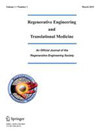
Regenerative Engineering and Translational Medicine
REGEN ENG TRANSL MED
期刊介绍
Regenerative Engineering is an international journal covering convergence of the disciplines of tissue engineering, advanced materials science, stem cell research, the physical sciences, and areas of developmental biology. This convergence brings exciting opportunities to translate bench-top research into bedside methods, allowing the possibility of moving beyond maintaining or repairing tissues to regenerating them. The journal encourages both top-down engineering approaches and bottom-up strategies integrating materials science with stem cell research and developmental biology. Convergence papers on instructive biomaterials, stimuli-responsive biomaterials, micro- and nano-patterning for regenerative engineering, elastomeric biomaterials, hydrogels for tissue engineering, and rapid prototyping and bioprinting approaches are particularly welcome. The journal provides a premier, single-blind peer-reviewed forum for the publication of original papers, authoritative reviews, rapid communications, news and views, and opinion papers addressing the most important issues and efforts toward successfully regenerating complex human tissues and organs. All research articles feature a lay abstract highlighting the relevance and future impact for patients, government and other health officials, and members of the general public. Bridging the gap between the lab and the clinic, the journal also serves as a dedicated platform for showcasing translational research that brings basic scientific research and discoveries into clinical methods and therapies, contributing to the improvement of human health care.Topics covered in Regenerative Engineering and Translational Medicine include:Advanced materials science for regenerative and biomedical applicationsStem cells for tissue regenerationDrug delivery for tissue regenerationNanomaterials and nanobiotechnology for tissue regenerationStudies combining tissue engineering/regeneration with developmental biologyConvergence research in pre-clinical and clinical phases
《再生工程》是一本国际性期刊,涵盖组织工程、先进材料科学、干细胞研究、物理科学和发育生物学等学科。这种融合带来了将实验室研究转化为临床方法的令人兴奋的机会,使其有可能超越组织的维护或修复而进行再生。该杂志鼓励自上而下的工程方法和自下而上的战略,整合材料科学与干细胞研究和发育生物学。特别欢迎关于指导性生物材料、刺激响应性生物材料、再生工程的微米和纳米图案、弹性生物材料、组织工程的水凝胶以及快速原型和生物打印方法的论文。该杂志提供了一个主要的、单盲同行评审论坛,用于发表原创论文、权威评论、快速通信、新闻和观点以及意见论文,讨论最重要的问题和成功再生复杂人体组织和器官的努力。所有研究文章都有一个简明摘要,强调了对患者、政府和其他卫生官员以及普通公众的相关性和未来影响。《再生工程》和《转化医学》的主题包括:用于再生和生物医学应用的先进材料科学用于组织再生的干细胞用于组织再生的药物输送用于组织再生的纳米材料和纳米生物技术用于组织再生的纳米材料和纳米生物技术将组织工程/再生与发育生物学相结合的研究临床前和临床阶段的融合研究
| 年发文量 | 42 |
| 国人发稿量 | - |
| 国人发文占比 | 0% |
| 自引率 | 5.3% |
| 平均录取率 | - |
| 平均审稿周期 | - |
| 版面费 | US$2890 |
| 偏重研究方向 | ENGINEERING, BIOMEDICAL- |
| 期刊官网 | https://www.springer.com/40883/?utm_medium=display&utm_source=letpub&utm_content=text_link&utm_term=null&utm_campaign=MPSR_40883_AWA1_CN_CNPL_letpb_mp |
| 投稿链接 | https://www.editorialmanager.com/RETM/ |
质量指标占比
| 研究类文章占比 | OA被引用占比 | 撤稿占比 | 出版后修正文章占比 |
|---|---|---|---|
| 50.00% | 7.87% | - | - |
相关指数
期刊预警不是论文评价,更不是否定预警期刊发表的每项成果。《国际期刊预警名单(试行)》旨在提醒科研人员审慎选择成果发表平台、提示出版机构强化期刊质量管理。
预警期刊的识别采用定性与定量相结合的方法。通过专家咨询确立分析维度及评价指标,而后基于指标客观数据产生具体名单。
具体而言,就是通过综合评判期刊载文量、作者国际化程度、拒稿率、论文处理费(APC)、期刊超越指数、自引率、撤稿信息等,找出那些具备风险特征、具有潜在质量问题的学术期刊。最后,依据各刊数据差异,将预警级别分为高、中、低三档,风险指数依次减弱。
《国际期刊预警名单(试行)》确定原则是客观、审慎、开放。期刊分区表团队期待与科研界、学术出版机构一起,夯实科学精神,打造气正风清的学术诚信环境!真诚欢迎各界就预警名单的分析维度、使用方案、值得关切的期刊等提出建议!
预警情况
查看说明
| 时间 | 预警情况 |
|---|---|
| 2025年03月发布的2025版 | 不在预警名单中 |
| 2024年02月发布的2024版 | 不在预警名单中 |
| 2023年01月发布的2023版 | 不在预警名单中 |
| 2021年12月发布的2021版 | 不在预警名单中 |
| 2020年12月发布的2020版 | 不在预警名单中 |
JCR分区 WOS分区等级:Q3区
| 版本 | 按学科 | 分区 |
|---|---|---|
|
WOS期刊SCI分区
WOS期刊SCI分区是指SCI官方(Web of Science)为每个学科内的期刊按照IF数值排
序,将期刊按照四等分的方法划分的Q1-Q4等级,Q1代表质量最高,即常说的1区期刊。
(2021-2022年最新版)
|
||
| ENGINEERING, BIOMEDICAL | Q4 |
关于2019年中科院分区升级版(试行)
分区表升级版(试行)旨在解决期刊学科体系划分与学科发展以及融合趋势的不相容问题。由于学科交叉在当代科研活动的趋势愈发显著,学科体系构建容易引发争议。为了打破学科体系给期刊评价带来的桎梏,“升级版方案”首先构建了论文层级的主题体系,然后分别计算每篇论文在所属主题的影响力,最后汇总各期刊每篇论文分值,得到“期刊超越指数”,作为分区依据。
分区表升级版(试行)的优势:一是论文层级的主题体系既能体现学科交叉特点,又可以精准揭示期刊载文的多学科性;二是采用“期刊超越指数”替代影响因子指标,解决了影响因子数学性质缺陷对评价结果的干扰。整体而言,分区表升级版(试行)突破了期刊评价中学科体系构建、评价指标选择等瓶颈问题,能够更为全面地揭示学术期刊的影响力,为科研评价“去四唯”提供解决思路。相关研究成果经过国际同行的认可,已经发表在科学计量学领域国际重要期刊。
《2019年中国科学院文献情报中心期刊分区表升级版(试行)》首次将社会科学引文数据库(SSCI)期刊纳入到分区评估中。升级版分区表(试行)设置了包括自然科学和社会科学在内的18个大类学科。基础版和升级版(试行)将过渡共存三年时间,推测在此期间各大高校和科研院所仍可能会以基础版为考核参考标准。 提示:中科院分区官方微信公众号“fenqubiao”仅提供基础版数据查询,暂无升级版数据,请注意区分。
中科院分区
查看说明
| 版本 | 大类学科 | 小类学科 | Top期刊 | 综述期刊 |
|---|---|---|---|---|
| 暂无数据 | ||||














